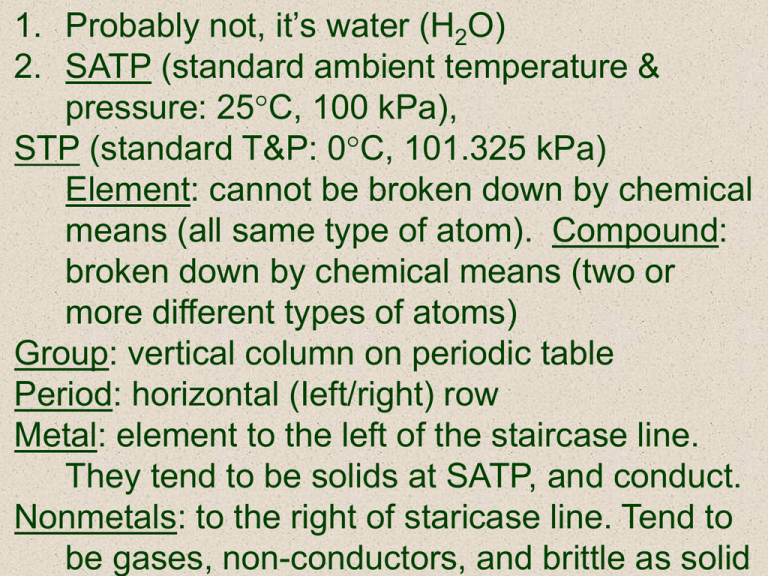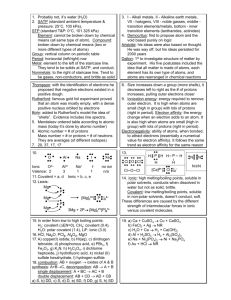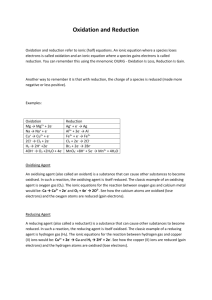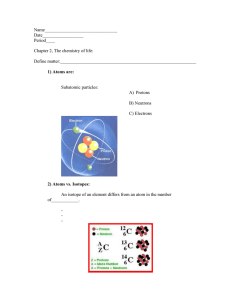Probably not, it’s water (H 1. O) 2. SATP (standard ambient temperature &
advertisement

1. Probably not, it’s water (H2O) 2. SATP (standard ambient temperature & pressure: 25C, 100 kPa), STP (standard T&P: 0C, 101.325 kPa) Element: cannot be broken down by chemical means (all same type of atom). Compound: broken down by chemical means (two or more different types of atoms) Group: vertical column on periodic table Period: horizontal (Ieft/right) row Metal: element to the left of the staircase line. They tend to be solids at SATP, and conduct. Nonmetals: to the right of staricase line. Tend to be gases, non-conductors, and brittle as solid 3. I - Alkali metals, II - Alkaline earth metals, VII - halogens, VIII - noble gasses, middle transition elements/metals, bottom - inner transition elements (lanthanides, actinides) 4. Democritus: first to propose atom and the void based purely on logic Aristotle: his ideas were also based on thought. He was way off, but his ideas persisted for 2000 years Dalton: 1st to investigate structure of matter by experiment. His five postulates included the idea that all matter is made of atoms, each element has its own type of atoms, and atoms are rearranged in chemical reactions Thompson: with the identification of electrons he proposed that negative electrons existed in a positive dough. Rutherford: famous gold foil experiment proved that an atom was mostly empty, with a dense positive nucleus orbited by electrons Bohr: added to Rutherford’s model the idea of “shells”. Evidence includes line spectra. 5. Mendeleev ordered table according to atomic mass (today it’s done by atomic number) 6. Atomic number = # of protons Mass number = # or protons + # of neutrons They are averages (of different isotopes) 7. 20, 37, 17, 17 8. Size increases down a group (more shells), it decreases left to right as the # of protons increases, pulling outer electrons closer 9. Ionization energy: energy required to remove outer electron. It is high when atoms are small (high in group) with lots of protons (right in period). Electron affinity: the energy change when an electron adds to an atom. It is also high when atoms are small (high in group) with lots of protons (right in period). Electronegativity: ability of atoms, when bonded, to attract electrons (essentially a numerical value for electron affinity). It follows the same trend as electron affinity for the same reason 10. O Al Na I Ions: O2– Al3+ Na+ I– Valence: 2 3 1 1 11. Covalent = a, d Ionic = b, c, e 12. Lewis: Mg P Xe no ion n/a [Mg]32+ [ P ]23– Mg P Mg 3Mg + 2P [Mg]32+[P]23– Mg + P: B-R diagram 2e12p+ 2e- 8e-2e12n0 5e- 8e- 2e- 15p+ 16n0 12p+ 2e- 8e12n0 8e- 8e- 2e- 1e12p+ 12n0 15p+ 16n0 12p+ 2e- 8e12n0 2e- 8e-2e- 1e5e- 8e- 2e12p+ 2e- 8e-2e12n0 2e- 15p+ 16n0 8e- 8e- 2e12p+ 2e- 8e12n0 15p+ 16n0 13. Cl O Cl Cl O Cl H P H H P H H N N H [Ca]2+ [ Cl ]2– N N 14. Ionic: high melting/boiling points, soluble in polar solvents, conducts when dissolved in water but not as solid, brittle. Covalent: low melting/boiling points, soluble in non-polar solvents, doesn’t conduct, soft. These differences are caused by the different strength of intermolecular forces in ionic versus covalent molecules. 15. In order from low to high boiling points: H2: covalent (EN=0), CH4: covalent (0.4), H2O: polar covalent (1.4), LiF: ionic (3.0) 16. HCl, Na2O, PCl3, Al2O3, MgO 17. A) copper(I) iodide, b) HI(aq), c) dinitrogen tetroxide, d) phosphorous acid, e) PBr5, f) Fe2O3, g) K3N, h) H2C2O4, i) dichlorine heptoxide, j) hydrofluoric acid, k) nickel (II) sulfate hexahydrate, l) hydrogen sulfide 18. combustion: AB + oxygen oxides of A & B synthesis: A+BC, decomposition: AB A + B single displacement: A + BC AC + B double displacement: AB + CD AD + CB a) S, b) DD, c) S, d) D, e) SD, f) DD, g) S, h) SD 19. a) Ca + CuSO4 Cu + CaSO4 b) FeCl2 + Ag NR c) H2O + Ca H2 + Ca(OH)2 d) Al + H2SO4 H2 + Al2(SO4)3 e) Na + Ni3(PO4)2 Ni + Na3PO4 f) Au + HCl NR For more lessons, visit www.chalkbored.com





